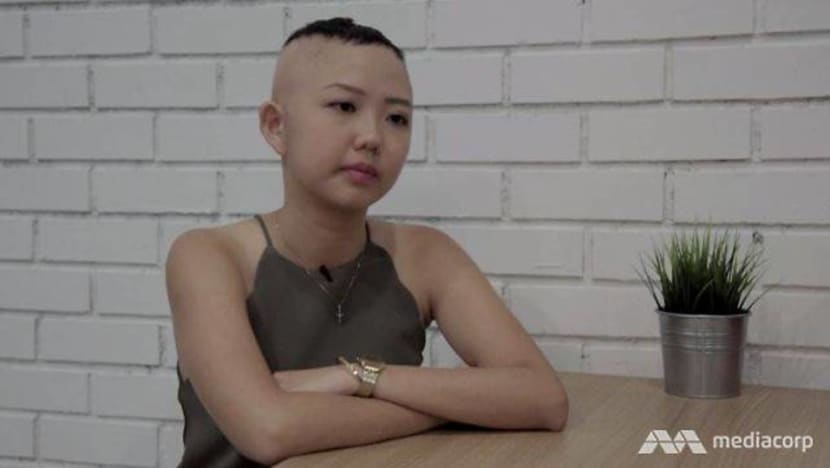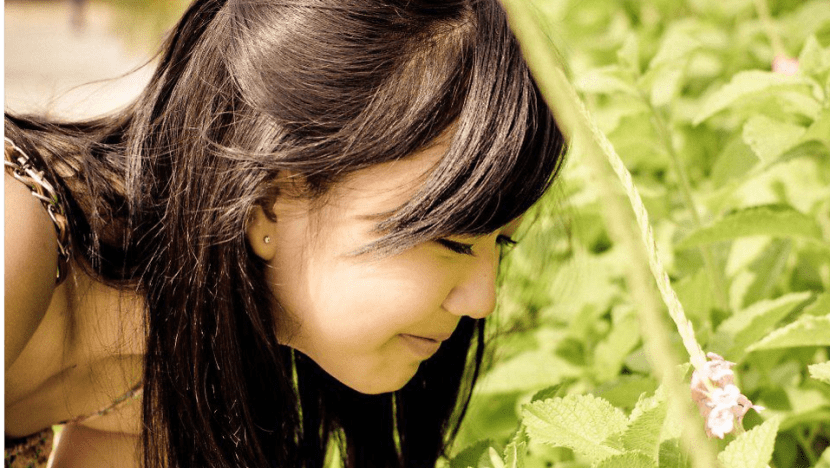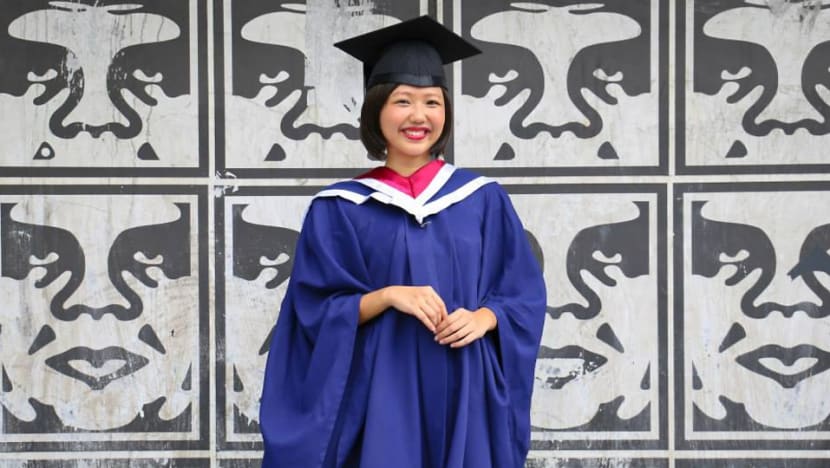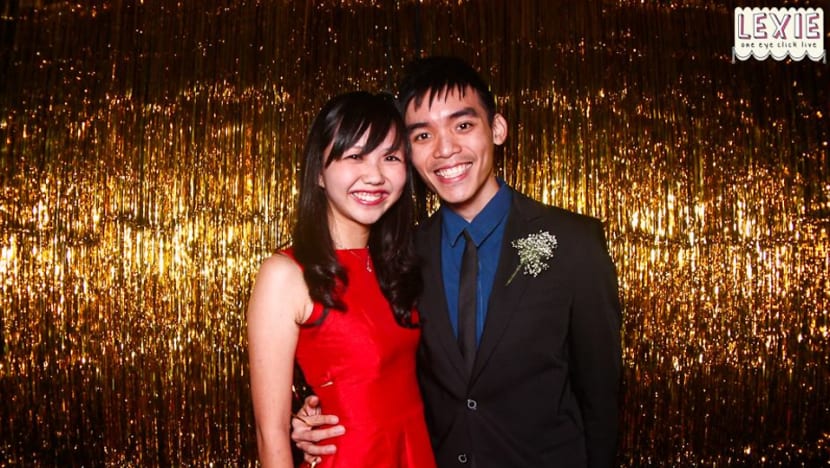‘It’s not just hair loss’: One woman's triumph over alopecia areata
Chan See Ting enjoys dressing up and looking good. But when she lost all her hair, she learnt valuable lessons of faith, courage and identity.

Chan See Ting, who has struggled with hair loss (Photo: Lianne Chia)
SINGAPORE: Of all her physical features, Chan See Ting loved her hair the most.
“I wore it very long, and it was very black and silky,” said the 25 year-old, as she flicked through Facebook profile pictures on her computer. “I was very proud of it.”
But all that remains of the long, silky locks she used to be so proud of is a small tuft in the centre of her scalp. Four years ago, See Ting was diagnosed with alopecia areata, an autoimmune disease where her body’s immune system mistakenly attacks the hair follicles, causing her to lose all her hair.
There is no cure.
HELPLESS
See Ting still remembers the day it all started: Jul 6, 2013.
She had been getting her hair done at a salon when the hairdresser alerted her to a thumbprint-sized bald patch on her scalp.

“I thought it was just stress, and I didn’t think very much about it,” she said. “But then there were all these bald spots that started spreading and soon, I realised my hair was starting to drop out in clumps.”
“It was so disgusting,” she added, grimacing. “I would just be sitting there talking to my friends, and pools of hair would just collect around me.” Every morning, her pillow would also be littered with strands of hair that had fallen in the night.
Steroids, she learnt, could suppress her immune system and stop the hair fall, but came with side effects. Nonetheless, she went ahead out of desperation, enduring multiple rounds of injections to her scalp, and taking oral steroids that made her bloat badly.
She recalled one of the most painful moments: sitting at the clinic, stony-faced, while the injections were going on.
“But the minute I stepped out of the clinic I just squatted in a corner of the long hospital corridor and bawled,” she said. “I felt so helpless at that moment, and I was so scared my hair would never grow back.”
PSYCHOLOGICALLY DISTRESSING
While there are no statistical assessments to show the prevalence of alopecia areata in Singapore, the condition can affect about 2 per cent of the population worldwide, according to Dr Joyce Lee, head of the National Skin Centre’s Hair and Nail Clinic. “We usually tell our patients there’s a 1 in 50 chance of a person getting alopecia areata at some time in their life,” she said.
The extent of hair loss can also differ from person to person, she added. Some may have a single round bald patch, while in other cases, the hair loss could affect the whole scalp, and even other hair-bearing areas like eyebrows and eyelashes. The complete loss of hair on the scalp and body is known as alopecia universalis.
Genetically, some people may also be more susceptible to developing the condition, added Dr Nisha Suyien Chandran, a consultant in the National University Hospital’s dermatology division. “Sometimes, there’s a family history of alopecia areata, or certain immune conditions, which can interact with environmental triggers like viral infections or stress to bring about the cascade of hair loss,” she explained.
The condition is benign and in some cases, the hair will regrow by itself without the need for any treatment or steroid injections.
But as See Ting found out, there is also a high chance of relapse. A topical treatment called DPCP had initially worked for her, and by early 2015, she was sporting a short pixie-cut crop of hair. But just a few months later, the hair started shedding and within three weeks, all her hair was gone.

TEARS AND TANTRUMS
Coming to terms with her condition was a struggle for See Ting, who candidly admitted that the process was a journey filled with tears and tantrums. She could not bear to look at herself in the mirror, and lost all enthusiasm for dressing up.
“It wasn’t just hair loss to me,” she said. “It was also a loss of my identity, and a loss of my femininity. I started to question, who was I as a person, and who was I as a woman?”
She also had to deal with a big fear: People talking behind her back.
“There was one time I was sitting on a train, and this elderly couple was sitting next to me. The lady turned to her husband and said in Hokkien, ‘oh, look at that poor girl beside you, she doesn’t have any hair, it must be that she’s a cancer patient and she’s going through chemotherapy.’ They assumed I didn’t understand, but I did.”
“It felt like a blow to my gut.”
But she now takes the opportunity to educate people about her condition.
“I think the biggest misconception people have when they see me is that I had cancer and I’m going through chemo,” she said. “I’ve heard it so many times I’ve lost count ... And there was a lot of indignance at first.”
“But then I realised it’s good that they tell me about their misconceptions so I can correct them, and sometimes, I’m the one that starts the conversation by telling them about alopecia upfront,” she added.
Till today, she remains grateful to her then-boyfriend, who – as she reflected ruefully – bore the brunt of her tantrums.
“He was this rock and just very steady, because I was so emotionally unstable and volatile,” she said. “I felt that he suffered a lot because he was the first person to get ‘hit’ in that sense. But he was so patient with me, and he never complained about how unreasonable I was.”
They are no longer in a relationship, but See Ting reiterated that it had nothing to do with her condition, and the two remain close friends.
“I had a lot of trust issues with men, and that played out big time in our relationship,” she said. “I think going through this whole alopecia episode was one reason why we can stay so close because you just get that fundamentally, you love each other even though it’s not in a romantic sense anymore.”

GOING PUBLIC
Interviewing See Ting was like speaking to an old friend. Dressed stylishly in an olive mini dress and white sneakers, her face was made up carefully, and framed by a thick shoulder-length black wig.
Cheerfully, she whipped it off to reveal the patchy regrowth on her scalp. “I like this wig because it’s the one that looks the most like my natural hair,” she said, stroking the wig and jokingly putting on a sinister face before bursting into peals of laughter.
See Ting is worlds apart from the woman she said she once was – and this can be partly credited to a bold step she took almost two years ago: going public about her condition.
She had published a heartfelt Facebook post detailing her struggle with alopecia, with the intention of starting a support group for people with the condition. It was shared by more than 15,000 people, and See Ting soon found herself inundated with requests to speak publicly about her condition.
“It was the first step to really coming to terms and accepting it,” she said. “I was so scared then, but I just felt like if someone actually felt as alone as I did then I hope to be the person who says, ‘you’re not alone’.”
She has also taken part as a “book” in the Human Library Singapore, where participants were allowed to “borrow” people to listen to their stories.
She added that she finally reached full acceptance in December last year, when she got a close friend to help shave her head, before going out without her wig.
“It was such a beautiful moment,” she said. “I was so at ease and so at peace with myself that I didn’t even notice whether people were judging me, or talking behind my back. I even forgot I was bald.”
Her frankness and willingness to share her story and challenge her fears head-on is striking. But telling her story, she said, gives her strength.

“I feel it is as if I am telling myself again and again who I am, and what I stand for,” she said. “And the story I keep telling is that there is strength in brokenness, strength in vulnerability, and beauty that everything that has happened.”
“I learnt that your pain will be your ministry,” she added. “It didn’t make sense to me back then, but now I look back and I’m grateful that alopecia happened to me.
"I’m grateful that I had to go through all this and be forced to think about my identity at such a young age because now I can do different things, and lead my life differently.”












